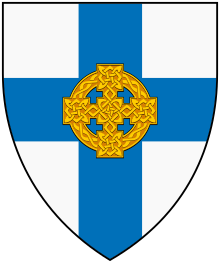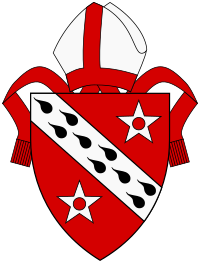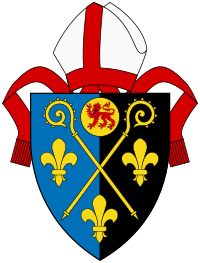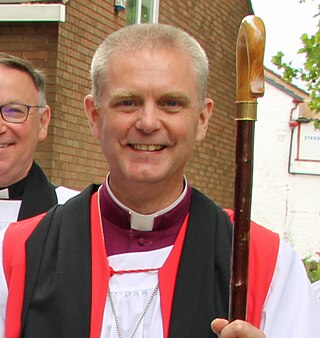

| Image | Details |
|---|---|
 | Bangor, recorded in 1512 Escutcheon:Gules a bend Or guttee-de-poix between two pierced mullets Argent. [2] |
 | St Asaph, recorded in 1512 Escutcheon:Sable two keys in saltire wards upwards Argent. [3] |
 | St Davids, recorded at unknown date Escutcheon:Sable on a cross Or five pierced cinquefoils of the field. [4] |
 | Llandaff, recorded at unknown date Escutcheon:Sable two pastoral staves endorsed in saltire the dexter Or the sinister Argent on a chief Azure three mitres of the second. [5] |
 | Monmouth, granted 20 April 1922 Escutcheon:Per pale Azure and Sable two croziers in saltire Or between in chief a bezant charged with a lion passant guardant Gules in fesse two fleurs de lys and in base one fleur-de-lys of the third. [6] |
 | Swansea and Brecon, granted 4 February 1924 Escutcheon:Per fesse Azure and Or in chief surmounting a Catherine Wheel issuant an eagle rising reguardant of the second and in base a fleur-de-lys of the first. [7] |

Canting arms are heraldic bearings that represent the bearer's name in a visual pun or rebus.
The Diocese of Niassa it is one of the eight Anglican dioceses of Mozambique, part of the Anglican Church of Mozambique and Angola. This diocese is geographically in the northwestern corner of the country, the others being the Diocese of Lebombo, Diocese of Nampula, the Missionary Diocese of Zambezia, the Missionary Diocese of Tete, the Missionary Diocese of Inhambane, the Missionary Diocese of Rio Pungue, and the Missionary Diocese of Maciene.
The Heraldry Society of Scotland was founded in 1977 with the aim of improving the study of heraldry.
George Alexander Way of Plean CStJ is a Scottish Sheriff and former Procurator Fiscal of the Court of the Lord Lyon in Scotland. In November 2015, it was announced that he was to be the first Scottish Sheriff to be appointed a member of the Royal Household in Scotland as Falkland Pursuivant Extraordinary at the Court of the Lord Lyon. In December 2017, he was promoted to Carrick Pursuivant in Ordinary. In 2020, he was appointed Chancellor of the Diocese of Brechin. In June 2021, he was appointed as Genealogist of the Priory of Scotland in the Most Venerable Order of St.John.

Ecclesiastical heraldry refers to the use of heraldry within Christianity for dioceses, organisations and Christian clergy. Initially used to mark documents, ecclesiastical heraldry evolved as a system for identifying people and dioceses. It is most formalized within the Catholic Church, where most bishops, including the Pope, have a personal coat of arms. Clergy in Anglican, Lutheran, Eastern Catholic and Eastern Orthodox churches follow similar customs, as do institutions such as schools and dioceses.

The Episcopal Diocese of the Central Gulf Coast is a diocese of the Episcopal Church in the United States of America, part of Province 4. The diocese was created in 1970 from portions of the adjoining dioceses of Alabama and Florida.

The Diocese of Cape Town is a diocese of the Anglican Church of Southern Africa (ACSA) which presently covers central Cape Town, some of its suburbs and the island of Tristan da Cunha, though in the past it has covered a much larger territory. The Ordinary of the diocese is Archbishop of Cape Town and ex officio Primate and Metropolitan of the ACSA. His seat is St. George's Cathedral in Cape Town.
The Diocese of Pretoria is a diocese of the Anglican Church of Southern Africa. It is divided into seven archdeaconries and has 61 parishes.
The Diocese of Johannesburg is a non-metropolitan diocese of the Anglican Church of Southern Africa. It was formed in 1922 from the southern part of the Diocese of Pretoria, and at that time included the whole of the southern Transvaal. Today it is much smaller, and comprises the central part of Gauteng province. The cathedral of the Diocese of Johannesburg is the Cathedral Church of Saint Mary the Virgin. The headquarters of the diocese and the bishop's office are situated at St Joseph's Diocesan Centre in Sophiatown, Johannesburg. The diocese oversees St John's College, Johannesburg, St Mary's School, Waverley, Bishop Bavin School, St Peter's College, Johannesburg and Vuleka Schools. The diocese has a total of 76 parishes

Nicholas Stratford was an Anglican prelate. He served as Bishop of Chester from 1689 to 1707.
The Diocese of Umzimvubu is a relatively new Diocese created out of a portion of the former St John's See. It came into existence in 1991 and is currently vacant after the ousting of bishop Mlibo Ngewu.
The Diocese of the Highveld is a diocese of the Anglican Church of Southern Africa covering the East Rand in Gauteng province and the southern part of Mpumalanga province in South Africa. The bishop's seat is at St Dunstan's Cathedral in Benoni.

The Bishop of Chester is the Ordinary of the Church of England Diocese of Chester in the Province of York.

New Zealand heraldry is the term for the style of armorial achievements, sometimes known as coats of arms, and other heraldic bearings and insignia used in New Zealand. It largely follows the Gallo-British tradition of heraldry also followed in England, Scotland, Ireland, Canada and Australia.

The armorial of British universities is the collection of coats of arms of universities in the United Kingdom. Modern arms of universities began appearing in England around the middle of the 15th century, with Oxford's being possibly the oldest university arms in the world, being adopted around the end of the 14th century. The earliest granting of university arms was to King's College Cambridge by Henry VI in 1449. Arms are granted by the College of Arms and Lyon Court. It has been suggested that new universities register arms in an attempt to appear more traditional or legitimate. As corporations, older university arms have historically been granted without a crest, however newer institutions use crests with mantling, including new colleges at older universities. The first crest granted to a university was to Leeds in 1905 while the first British university to be granted supporters was Sussex in 1962, although both Oxford and Cambridge have used angels as supporters and Cambridge has used the 'alma mater' emblem as a crest without these components being officially granted.

This is a list of the official historical coats of arms or 'full heraldic achievements' of English primary and secondary education schools, grouped by region, as granted by the College of Arms. For some schools, the full heraldic achievement is displayed; for others just the escutcheon (shield) is shown.

England has a long tradition of ecclesiastical heraldry. An Anglican bishopric is considered a corporation sole, and most have been granted official arms. Incumbents may impale their personal arms with those of their see.
This is a list of the armorial of the Scottish Episcopal Church, sorted by diocese. The Scottish Episcopal Church is a Christian church organization of Scotland.

The Catholic Church in Scotland is divided into two provinces while the Catholic Church in England & Wales is divided into five.